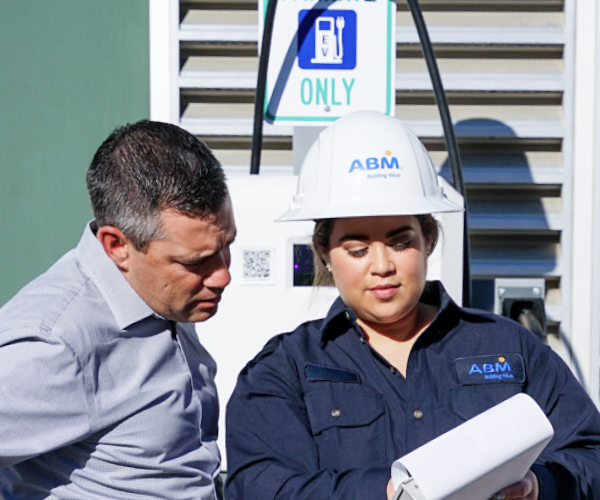|
|
| New buildings and old surround the athletic field. Georgetowns facilities teams must take into account all athletic events and practices. Credit: Jay G. Branch |
Even in the best of times, maintaining a large urban university is no easy task. In the case of Georgetown University in Washington, DC, there are more than 12,000 students to feed, house and educate. The university is located in a city that has only recently started to make strides in reducing crime and making its local bureaucracy more efficient. Aside from classroom buildings and residence halls, Georgetown’s facilities include 70 off-campus student resident townhouses, priceless oil paintings in various buildings on campus, and a recycling center that processes 60-70 tons of material each month.
Add to that the age of some of the facilities. Some campus buildings date back a century or two and require special care. For example, the delicate stained glass windows in Dahlgren Chapel had to be sent to specialists for cleaning and restoration. No cleaning with Windex and replacing broken glass panes here.
But these are not the best of times for many maintenance organizations across the country, and Georgetown is only one of thousands of universities and other organizations that have been forced to implement maintenance budget cuts. The cuts have forced the facility management department at the university to be even more careful and creative in its planning and project prioritizing than before. “There was no way we could do both maintenance and preventive maintenance with the shortage of staffwe faced aft er the budget cuts,” said Richard Payant, CFM, CPE, director of facilities management. “We have a lot of older buildings on campus, many of them more than 40 years old. So as the cuts continued, we began looking for funding to replace systems on a component basis. We also spent a lot of time educating the financial staffand business officers on the need for funding of specific requests.” So how does a university like Georgetown and thousands of other organizations facing similar operations and maintenance (O&M) budget cutskeep facilities operating normally on a limited budget? For Payant, it has been an ongoing question. “For the last decade or so, the mission of facilities management to serve the greater university community has been increasingly tied to that one question,” he said. “How can the department reduce costs and increase efficiencyand at the same time remain environmentally conscious in Georgetown’s collective move toward sustainability?”
A well-trained staff, good planning, construction of newer facilitiesand renovation of older, outmoded facilities are helping his team successfully cope with the financial realities that face O&M departments at organizations throughout the country.
Bright Stars on the Horizon
|
|
| With much of the campus built on a hillside, maintaining all the stairs can sometimes be a challenge for the facilities management team. Credit: Jay G. Branch |
For a university with as much history as Georgetown, the effects of maintenance cuts are nothing new. Back in the Civil War, the mother of two of the 17 students who still had not left Georgetown to fight in the war, found the conditions of her sons’ dormitory dining hall so unacceptable that she donated money to have it completely renovated, including chandeliers. She wanted to be sure her sons ate in the kind of atmosphere they were accustomed to eating in.
Parents of students today are likely to be much more impressed with the condition of Georgetown’s current residence halls, thanks in part to recent construction of several new residence halls, including those in the 1 millionsquare- foot Southwest Quad.
But new residence halls are not the only bright stars on the horizon of the Georgetown Campus. The Rafik B. Hariri Building, the university’s new business school building, recently received LEED Silver certification for sustainability and has won awards for its architecture and construction trades. Construction is now underway for a new science center complex, and once that construction is completed, the outdated Reiss Science Center, built in the 1960s, will be totally renovated.
Training Initiatives
One way that Georgetown has coped with budget cuts is by ensuring that its employees are trained in the latest techniques for maintenance and operations. The goal is to ensure they are trained to work as efficiently as possible, helping to compensate for reduced O&M staff. For example, Fleet Manager James Connor and Garage Supervisor Sheldon Harley attended training at the University of West Virginia, where they participated in a two-day course providing basic understanding of the technology and application of battery-electric and hybrid- electric vehicles. And Electronic Systems Analyst Al Brown facilitated several training sessions in fire alarm response for O&M staff.
|
|
| Solar-powered trash compactors and recycling containers have been placed throughout the campus. Credit: Jay G. Branch |
Sustainable buildings like the new business school facility require some special procedures, so even before the Hariri Building was dedicated, plumbers, mechanics, electricians and custodians were given special training. Most of the training occurred during the day, but maintenance mechanics on the night shift had to be trained when they arrived for their shifts at 11 o’clock at night. At each building’s Fire Command Center, employees had to be trained to use microphones. “Some people were not comfortable with hearing their voices over a loudspeaker,” noted Marianne Green, training manager. “So we made them repeat fire alert announcements over and over until they were used to it.”
Environmental Initiatives
One thing that the O&M staffat Georgetown wanted to ensure was that budget cuts did not adversely impact the university’s strong commitment to environmental initiatives. Along those lines, they maintained or instituted environmental programs such as: Recycling and Solid Waste Upgrades Bill DelVecchio, recycling and solid waste manager, currently leads a program to recycle 45 percent of waste, and hopes to increase that number to 50 percent in this academic year. Despite budget cuts, the recycling and solid waste programs have “taken offin the past three years,” he said. Alongside 20 solar-powered compactors, the department added new stations and desk-side containers across campus to increase recycling rates. The compactors send signals to DelVechhio’s office when compactors are full, so trash and recycling can be collected before it overflows, or squirrels and other rodents get to it. Installation of Waterless Urinals and Recycling Drain Water Despite the initial cost, these initiatives save thousands of gallons of water a year while protecting the environment. Each of Georgetown’s waterless urinals alone save 40,000 gallons of water each year, and reduce routine maintenance. Compact Florescent Light bulb (CFL) ProgramFor the past three years, the university has been phasing in compact CFL bulbs as traditional lights die out. In addition to helping the environment, just 175 of the thousands of CFL bulbs the university has installed saved close to $5,400even though the bulbs themselves cost only $3 each more to purchase than incandescent bulbs.
Green roofs The university uses vegetative roofing at several buildings, including the Leavey Center and the newly constructed Southwest Quad. According to Payant, Georgetown has had green roofs on campus for 20 years, “even before it was called green roofing.” BiofuelsBiodiesel blends have been used in Georgetown transportation buses and other staffvehicles since October 2009. A university publication noted that “using domestic sources helps local economies and works to reduce dependence on foreign crude oil.”
ARAMARK Manages Georgetown University and Conference Center
ARAMARK, a world leader in professional services, currently operates the Georgetown Hotel and Convention Center, located on the Georgetown campus. Under terms of the contract signed in 2008 between Georgetown and ARAMARK Higher Education, ARAMARK is responsible for all management and operational functions of the property. “The Georgetown University Hotel & Conference Center exemplifies ARAMARK’s continued commitment to provide higher education institutions with innovative learning and leisure environments,” said Michael Leone, senior vice president, ARAMARK Higher Education. “Its conference center facilities, combined with an ideal location on the campus of one of the nation’s most elite higher education institutions, provide the perfect backdrop for both leisure and business guests.”
Located in the heart of the Georgetown University campus, Georgetown University Hotel & Conference Center offers guests a wide array of meeting rooms, recreational services and lodging amenities as well as convenient access to Washington D.C. attractions.
The Conference Center offers 146 guest rooms, 14 meeting rooms with over 13,500 square feet of meeting space, a ballroom that boasts 10,500 square feet when used in its entirety, wireless Internet access, and a fully equipped business center. The ballroom can be broken down into eight different configurations, along with smaller individual conference rooms surrounding the ballroom for additional breakouts. For more information or to book your next trip to Georgetown University Hotel & Conference Center, log onto www.ahl-georgetown.com.
About ARAMARK Higher Education
ARAMARK Higher Education is dedicated to excellence in dining, facility, conference center, and stadium and arena services. ARAMARK enhances the living and learning experience and environment for more than 600 colleges and universities throughout North America.
Green CleaningGeorgetown has a goal of using certified, environmentally friendly cleaning supplies, including the use of “activated water” which consists of electrically charged water created by the process of electrolysis. The small charge in the water is an effective disinfectant, reducing or eliminating the need for harmful chemicals.
Microfiber cleaning cloths and mops made from recycled plastic that hold 60 times their weight can withstand hundreds of launderingsreducing the waste (and cost) of disposed mop heads and cleaning cloths. For some, the initial cost of these programs real or perceivedmight seem frivolous at a time when O&M is still dealing with the ramification of budget cuts. But the O&M team at Georgetown sees it differently, particularly since many of these programs actually end up saving the university money in the longer term.
As Payant sees it, some things are not just about dollars and cents. “Are we sustainability conscious? You bet!” he said. “Our environmental initiatives are helping us to enjoy a cleaner and healthier environment while doing our part. Our motto at Georgetown continues to be: ‘bleed blue, wear grey and think green.'”
Maintenance Planning Helps Maximize Resources
Georgetown uses short-, medium- and long-term planning to maximize the effectiveness of the university’s O&M staffand equipment. They must plan months, or even years ahead for the student move-ins and move-outs, preparation and cleaning of classrooms and common areas, sports and other events.
No matter how much long-term planningor how sophisticated the maintenance software an organization uses there are times when shorter-term, more reactive planning must take precedence. Some of the most important planning is done when “we have an 8 a.m. meeting every day for 15-20 minutes,” Payant noted. “Our objective is to talk about last night, today and tomorrow.”
What do they talk about most at those meetings? “The weather and upcoming special events that require O&M support,” he said. “For us, it’s an extremely important topic. For example, if there is a storm coming in next two days, we would want to take look at storm drains. If it is winter and a snowstorm is forecast in the next two to five days, we want to make sure there is enough salt and sand and that the plows are mounted. We also need cots in case our people need to sleep over.”
In one particularly bad snowstorm last winter, Georgetown’s maintenance team had to stay overnight for nine straight nights. Even though the university was officially closed, the 5,000 students who remained on campus needed access to the library, fitness center and residence halls, so maintenance teams focused on keeping campus paths cleared.
“At times like that,” Payant said, “you have no choice but to ignore the long term, and focus on the short term day-today items.”







